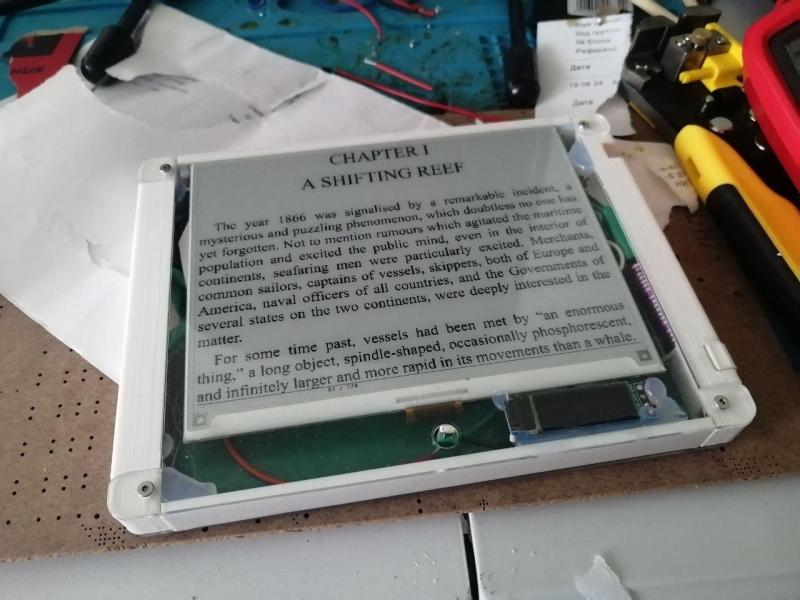Modern e-readers such as the Amazon Kindle are incredible pieces of engineering, but that doesn’t mean there’s no room for improvement. A device custom-built to your own specifications is always going to provide a more satisfying experience than something purchased off the shelf. That’s why [fel88] put together this custom e-reader which offers a number of unique features, such as a solar panel on the back and button-free operation.
One issue with modern e-readers, at least as [fel88] sees it, is that they have a lot of unnecessary features. This project removes most of them, stripping down the device to its core functionality: a straightforward menu for selecting books and gesture-sensing for navigating the menu as well as changing the pages. The only physical input on the device is a small reed switch to turn the device on. A 3D printed case holds the e-ink display and encloses the inner workings, driven by an Arduino Mega 2560 and powered by three lithium-ion capacitors (LICs) and a small solar panel.
By dropping all of the unnecessary features, the device doesn’t need to waste energy with things like WiFi or Bluetooth and can get around 880 pages on a single charge, not counting any extra energy coming in through the solar panel while it’s operating. The LICs will also theoretically improve its life cycle as well. If you’re still stuck with a paperweight when you formerly had a working e-reader, though, there are plenty of ways to bring old devices back to life as well.

















There is an accelerometer that functions as an input device to turn pages and some other stuff. Thank you for not having a YouTube video that needed to be sifted through for that info
Thank for saving me from having to do that. “The only physical input on the device is a small reed switch to turn the device on.” No, that’s wrong. You have to be able to pick books and turn pages. I guess the OP considers the accelerometer to be a logical input only.
Amazing work! Hope someone can take everything and turn it into a proper PCB and enclosure with even better ingress protection
I have a soft spot for robust/ruggedised/post-apocalyptic rated tech. I wanted to make a pip boy of my own but then I realised its actually quite impractical in real life. I now think LoRa or similar based eink texting devices are more suitable.
I wonder if it would make sense for the rear solar panel to be reversible, so it can charge while you are reading.
Or, better yet, add a transparent solar panel in the front.
A transparent solar panel can’t exist. Transparency let’s light pass through, but for the solar panel to work, it needs to capture the photons.
So at no point before writing this did you think “What if the panel only captured some of the photons”?
Translucent is the word for when something lets light through but diffuses / blurs it. Sunglasses are transparent. You do lose brightness / contrast when you put additional layers on top of e ink, but a very minimal panel might not be too extreme. I believe there are watches which may do things like that so that the panel isn’t obvious.
Solar watch panels are part of the watch face, behind the hand.
Usually “transparent” means passing all the light, while “translucent” implies partial transmission.
Ah, that’s right, they switched to a translucent face with a (presumably) regular panel behind. I used to have one where the panel was on top but wasn’t very clearly defined, although I think it was still opaque. I’m not sure which device it is that I saw with the panel on top and light still passing thru then.
And as for transparent vs translucent, I think “usually” is going too far. If someone says “transparent solar panel” then I find it unreasonable or at least impolite to assume that they meant something obviously impossible instead of something fairly reasonable. Especially since if they had said translucent, someone who defaults to the other usage could say “but if it was blurry then how could I read the screen underneath?”.
If we get specific to solar panels, I see more results say transparent than translucent when looking at concepts for windows, so this could also be a case of jargon or marketing terms. Or they could mean “partially” transparent, while assuming the reader will naturally assume that a solar panel does have to block some light and so will understand. I would think it more realistic to have a panel that’s just too thin for full absorbtion, rather than one with a really high energy band gap. Technically, if it was thin enough to only absorb a couple percent, you could offset that with an antireflective coating to make up for the couple percent that normally bounces off.
there are at least some photons (coming from the sun) we can’t even “see” (UV light).
An “invisible” PV panel could still harvest those I assume.
And considering the limited color range of e-ink displays I’m sure there’s some combination of colors where the PV panel can get one or two more ranges (only a small range of the spectrum for the e-ink display).
Not saying it’s theoretically possible nor technically feasible (or economically sensible(?)) – just maybe.
It depends on the photon energy and the semi conductor band gap. You can’t actually convert UV to electron efficiently (and transparently), since we don’t know of any semi conductor with this band gap. Silicon can convert IR to a small current, but it’s not transparent either. I only know about diamond to be compatible with both requirement (a band gap of extreme UV at 220nm for 5.6eV), but it’s too expensive to produce.
And extreme UV doesn’t work inside a building since standard windows are made of glass that blocks UV.
I have a scribe. I quite like it great for reading, but there are some things I find irritating – you can’t copy and paste from a book/document into a notebook on the same device, and also although the AI is remarkably good: it can even read my virtually illegible handwriting, but it converts it into a graphic, not text… meaning if I wanted to compile a short report of my own based on pdfs on the device and my own notes, it would need multiple devices and programs to do so, not to mention sending myself multiple emails. This is a great shame, as the device is obviously capable of doing these basic things without needing a PC, but they just chose not to implement them.
The simplicity of it is great. I’m very impressed this is a microcontroller based project and not a single board computer project. I’ll have to check out their code to see how they are getting data on there, and how the user navigates documents.
I like having buttons on my e-reader. Specifically, mine has buttons for next page and previous page. The next page button is under my thumb when I hold the device along its edge, which means I can go to the next page just by tightening the grip of my thumb, no movement necessary. Kobo Libra 2.
Without buttons, turning the page requires two hands.
Also a fan of buttons on e-readers. Swiping is an involved motion in comparison to pressing a button.
An old friend of mine who had trouble using his hands found the original Kindles to be a fantastic boon — he could turn pages on a book by himself after 40 years of not being able to. Then, a couple years later, they took that away in favor of screen gestures…
Sometimes simpler interactions are bettter. That said, it would be super easy to replace the accelerometer here with a couple buttons if you wanted to.
One of the things I loved about my SE P910 was the 5-way jog wheel and I wish modern phones would bring it back. Having one on an e-reader would make perfect sense.
I have one of the really old Kindles (it has wifi so is not subject to the outrage) with buttons on the side. It has to be at least 15 years old by now, battery still lasts a month. As much as I love the buttons and despise unnecessary touch screens, this dude’s implementation of an accelerometer seems really cool. Since it is a homebrew project I bet you could tune it so that a subtle shake exactly how you do it would flip the page for you. I gotta say that would be a huge benefit of a bespoke device- that kind of UI could never work for mass market. Either that or make you insane by never working quite right, hahaha but that is all homebrew projects, for me at least!
I have a couple of seconhand kindle 4 paper white that are my favorites. The have the edge buttons that in my opinion is the best ergonomic solution.
The next generation with touch sensitive screen is not confortable for me.
The real kindle problem was they added a backlight and made the battery tiny at the same time. So the only real things it had going for it, paper like readability and battery life went out the window.
Real facepalm moment. Mine are always dead when I want to read, can’t pack them on a trip because they always need charging.
And of course the touch controls are horrid. If they let you at least plug in a headset and use the button to flip the page that would be something.